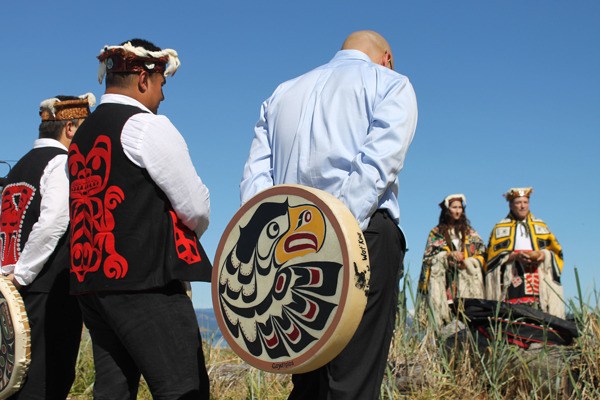Heavy drumbeats from across the water announced the arrival of the Chief George Hunt Memorial Dance Group to Henry Island Friday, Aug. 7. The members of Kwakwaka’wakw Nation came to bless a totem pole commissioned by Craig Tall for McCracken Point, carved by Tom D. Hunt, son of hereditary Chief George Hunt and Mary Hunt.
The 9,000 pound totem pole was carved from a single tree, and started out weighing seven tons. The pole features an eagle at the top with its wings outstretched, a seal, sea lions, salmon eggs, a raven and an orca whale, as well as a bubble man, a traditional figure in Kwakwaka’wakw Nation artwork. Kwakwaka’wakw means “people who speak Kwak’wala,” and the First Nations group is made up of many Kwak’wala speaking tribes from Vancouver Island and British Columbia.
“It is the aesthetic of where we come from, that is what the art form means,” explained Kevin Cranmer of the Kwakwaka’wakw Nation to the crowd gathered at the totem pole. Cranmer explained that each animal and carving represented a familial link, or connection to a place.
Tall said he hoped that the totem pole could be a gift to McCracken Point, which faces Canada, and to the San Juan Islands as a whole. He thanked Lee Brooks of Arctic Raven Gallery, Deb Nolan, and Henry Island caretakers Mark Yerex and Lori Twietmeyer for their help with the immense project.
“We talked a lot about what story we wanted to tell with the totem pole,” Tall said. “Instead of telling the story of our family, we wanted to tell the story of the animals on McCracken Point.”
According to Tall’s daughter Kristina Gladstein, the totem pole and the blessing ceremony were life-long wishes finally fulfilled for her and her father, recalling her childhood time spent in the islands and on Henry Island with her family.
“To get the opportunity to take care of this land feels so special, it’s a real responsibility,” Gladstein said of McCracken Point. “To own this piece of land, we really feel more like stewards.”
Mike Vouri, San Juan Island National Historical Park Historian, gave a brief history of how Henry Island came to be named. Charles Wilkes of the United States Exploring Expedition (1838-1842), also known as the Wilkes Expedition, was in Fiji with his nephew Henry. Two longshoremen and Henry took a boat ashore to one of the smaller islands to begin an exploration. Then, from the main ship further out, Charles Wilkes could only watch as Fijians overtook the boat and murdered Henry and the longshoremen, leaving him distraught and feeling responsible for his the death of his nephew.
When Charles Wilkes and his expedition arrived in the San Juan Islands, Wilkes renamed the Spanish island names with British ones, and named one after his dead nephew.
James Alden, who served as midshipman on the Wilkes Expedition, came back to the islands for the U.S. Coast Survey and restored many of the Spanish names to the islands, but kept the name Henry Island in remembrance.
During the blessing ceremony, Chief Bill Cranmer, Tall and Gladstein encircled the totem pole wearing traditional Kwakwaka’wakw robes and headdresses made of abalone shell and fur. As the ceremony commenced, they walked around the pole and dusted the ground with eagle down to bless the guests and earth. A Tła’sala, or peace dance, was performed after the blessing, and Chief Cranmer spoke to the crowd about the importance of keeping First Nation cultures vibrant, reminding the audience that Kwakwaka’wakw ceremonies such as these were banned from 1884 until 1951.
“All of our people can be proud of what we see here today,” he said. “It takes a lot to hold these things together, when talking about our history and our culture.”
The ceremony then moved to a meadow, where the group performed the Hamat’sa, narrated by Chief Cranmer, which told the story of the spirit of Baxbaxwalanuksiwe’, the man eater from the North end of the world, by dancing, singing and drumming. The dancers wore a variety of elaborate robes, ornate headpieces and complex bird masks, carved and painted with flawless lines. The dancers snapped the moveable beaks and cocked their heads back and forth, ensconced in shredded cedar bark and sprinkled with eagle down to embody the energy of a bird.
The transformation mask, a bland name compared to its stunning display, was also worn at first looking like another bird mask until the dancer pulled strings that opened the mask to reveal five panels with intricately carved faces.
After Chief Cranmer spoke a final thank you to Tall, Gladstein and those in attendance, the guests wandered off across the grasses to return to their respective islands, marveling at the stunning display of art, performance and tradition.




